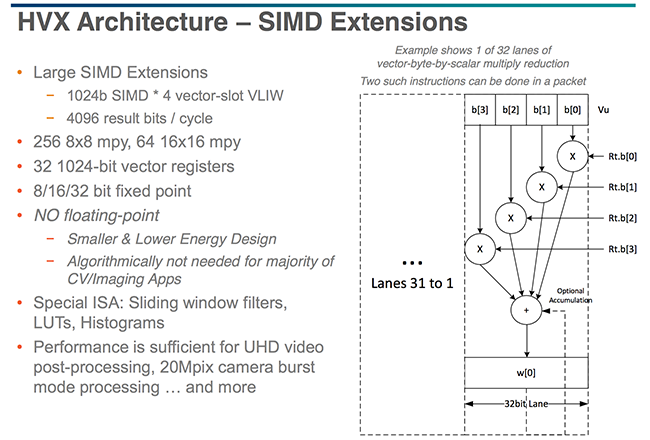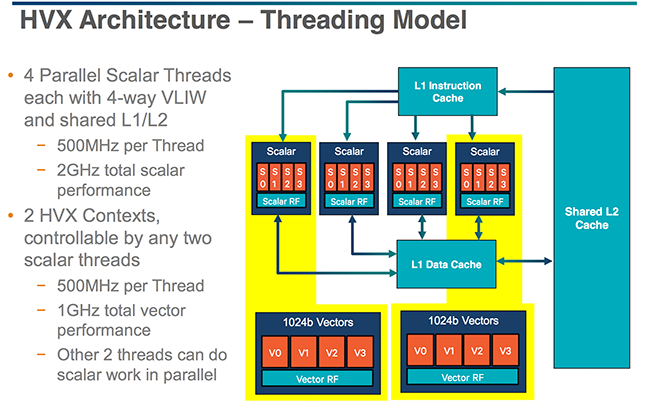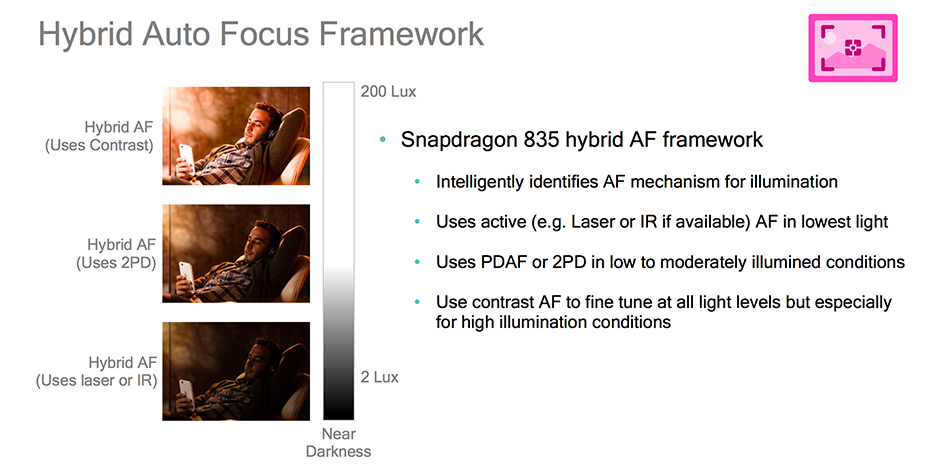Qualcomm Details Snapdragon 835: Kryo 280 CPU, Adreno 540 GPU, X16 LTE
by Matt Humrick on January 3, 2017 5:00 PM EST- Posted in
- Smartphones
- Snapdragon
- Qualcomm
- Adreno
- Mobile
- Snapdragon 835
- Kryo
CPU
The Kryo 280 CPU inside Snapdragon 835 is the first semi-custom architecture to use ARM’s new "Built on ARM Cortex Technology" license. This license (which we abbreviate as BoC) sits between the traditional Cortex processor license, which grants the vendor access to one of ARM’s stock cores, and the architecture license, which allows the vendor to create a completely custom design that conforms to ARM’s ISA. Over the past three generations, Qualcomm has used all three of these licenses: the Snapdragon 810 implemented stock ARM Cortex-A57 and A53 cores with a processor license, the 820’s fully-custom Kryo cores required an architecture license, and the 835 takes advantage of this new license type.
The BoC license allows Qualcomm to make certain changes to a stock ARM core, thereby, creating a semi-custom core that aligns more closely with its performance and power targets, achieves better integration with its proprietary IP (GPU, DSP, etc.), and is specially tailored to the workloads and applications Qualcomm is targeting. There are parts of the microarchitecture that cannot be altered, however. The decoder width and execution pipelines are off limits, for example, because the amount of redesign would be too extensive. For this reason, many of the possible changes involve branch prediction and instruction fetch in the front end.
For the Kryo 280, Qualcomm uses an octa-core, big.LITTLE configuration with four “performance” cores and four lower-power “efficiency” cores, with semi-custom designs for both clusters. Qualcomm did not disclose which ARM cores serve as the foundation for Kryo 280, but the Cortex-A53 is the obvious choice for the efficiency cores, while the performance cores are likely based on the A72 or A73. As expected, Qualcomm did not go into great detail about what modifications it made, but it did confirm that the memory controllers are a custom Qualcomm design. It’s not clear if it uses ARM’s CCI-550 Cache Coherent Interconnect or its own internal solution, though. The performance cores also get a larger instruction window, which determines the number of instructions that can be executed out of order. This potential performance booster requires modifications to several features, including the reorder buffer and issue queues.
Kryo 280’s efficiency cluster reaches a peak frequency of 1.9GHz, while the performance cluster tops out at 2.45GHz, which seems a bit conservative. According to ARM, the A73 is comfortable running between 2.6GHz to 2.8GHz when using the 14/16nm node. This number could be even higher using Samsung’s new 10nm process, which the Snapdragon 835 uses. There are a few possible explanations that come to mind: Kryo 280’s performance cores are based on the A72 instead of the A73; the changes Qualcomm made, particularly the ones to increase the instruction window size, are limiting the peak frequency; more of the thermal budget is being used for the GPU; or Qualcomm is prioritizing battery life over peak performance. I suspect there’s still some headroom available, leaving the door open for a Snapdragon 835 variant with higher CPU frequencies later this summer.
The Kryo 280’s L2 caches have doubled in size relative to those in the Snapdragon 820. The efficiency cluster uses a 1MB L2 cache, while the performance cluster uses a 2MB L2 cache. The larger caches increase performance and reduce power consumption at the same time by reducing memory traffic, according to Qualcomm.
At this point you’re probably wondering why Qualcomm went the semi-custom route for Snapdragon 835’s CPUs instead of using its custom Kryo architecture? The company said that it considers all of the available options (stock ARM, custom, and now semi-custom) for each generation and selects the best technology. Performance and power are obvious criteria, but other factors like cost, availability, and marketing affect this decision too.
| Qualcomm Snapdragon SoCs: Three Generations | |||
| SoC | Snapdragon 835 (MSM8998) |
Snapdragon 820 / 821 (MSM8996 / MSM8996 Pro) |
Snapdragon 810 (MSM8994) |
| CPU | 4x Kryo 280 Performance @ 2.45GHz 4x Kryo 280 Efficiency @ 1.90GHz |
2x Kryo @ 2.15GHz / 2.34GHz 2x Kryo @ 1.59GHz / 2.19GHz |
4x Cortex-A57 @ 2.00GHz 4x Cortex-A53 @ 1.50GHz |
| GPU | Adreno 540 | Adreno 530 @ 624MHz / 653MHz | Adreno 430 @ 630MHz |
| Memory | 2x 32-bit @ 1866MHz LPDDR4x 29.9GB/s |
2x 32-bit @ 1866MHz LPDDR4 29.9GB/s |
2x 32-bit @ 1600MHz LPDDR4 25.6GB/s |
| ISP/Camera | Dual 14-bit Spectra 180 ISP 1x 32MP or 2x 16MP |
Dual 14-bit Spectra ISP 1x 25MP or 2x 13MP |
Dual 14-bit ISP 1x 21MP |
| Encode/Decode | 2160p30 (2160p60 decode), 1080p120 H.264 & H.265 |
2160p30 (2160p60 decode), 1080p120 H.264 & H.265 |
2160p30 (2160p60 decode), 1080p120 H.264 & H.265 |
| Integrated Modem | Snapdragon X16 LTE (Category 16/13) DL = 1000Mbps 3x20MHz CA, 256-QAM UL = 150Mbps 2x20MHz CA, 64-QAM |
Snapdragon X12 LTE (Category 12/13) DL = 600Mbps 3x20MHz CA, 256-QAM UL = 150Mbps 2x20MHz CA, 64-QAM |
Snapdragon X10 LTE (Category 9) DL = 450Mbps 3x20MHz CA, 64-QAM UL = 50Mbps 1x20MHz CA, 16-QAM |
| Mfc. Process | 10nm LPE | 14nm LPP | 20nm SoC |
GPU
The Snapdragon 835 includes an updated Adreno 540 GPU. It uses the same basic architecture as the Adreno 530 in Snapdragon 820, which accounts for the product number’s small increment. For this generation, Qualcomm focused on optimizing bottlenecks and reducing the amount of work done per pixel by improving depth rejection, for example. The ALUs and register files also received some attention, although, nothing specific was mentioned.
The Adreno 540 performs higher-order texture filtering at lower cost relative to previous designs, processing 16 texels/clock for trilinear filtering. For comparison, ARM’s Mali-G71 processes 1 bilinear filtered texel per clock, or 1 trilinear filtered texel over 2 clocks, per core. So a 16 core configuration (MP16) is capable of 16 texels/clock (bilinear) but only 8 texels/clock (trilinear).
According to Qualcomm, the Adreno 540 sees a 25% increase in 3D rendering performance relative to the Adreno 530 in Snapdragon 820. It’s not clear how much of this is due to architectural improvements, however, because the peak GPU frequency is not official; initial clues point to a modest frequency boost for the GPU, although not enough to account for the claimed 25% increase in performance.
The Adreno 540 supports the latest graphics APIs, including OpenGL ES 3.2, DirectX 12, and Vulkan. It also includes full support for OpenCL 2.0 and Renderscript.
DSP & ISP
Last year, Qualcomm introduced a completely new architecture for the Hexagon 680 DSP in Snapdragon 820, featuring its new Hexagon Vector eXtensions (HVX) specifically designed for advanced photo and video processing, virtual reality, and computer vision workloads. The Hexagon 680 can work on two vector threads in parallel using two HVX contexts, each containing four 1024-bit SIMD pipelines, which are significantly wider than the 64-bit SIMD NEON pipelines typically found in ARM CPUs, allowing each HVX context to work on 4,096 bits/cycle compared to 128 bits/cycle for a single CPU core.
In addition to the two HVX contexts for vector instructions, the Hexagon 680 also contains four threads for scalar instructions, each with 4 VLIW pipelines. Scalar and vector instructions can be processed in parallel too, using two scalar threads and two vector threads. This allows concurrent execution of audio and imaging tasks, because the scalar threads generally handle audio and voice processing.
While the Hexagon 680 DSP uses a multithreaded programming model similar to a CPU, it’s still a specialized processor designed to accelerate specific workloads involving streaming data. It’s meant to work alongside the CPU and GPU rather than replace them. For example, in order to reduce die space and power consumption, it only performs integer and not floating point operations. This specialization gives the DSP a significant performance and power advantage over the CPU for certain tasks.
Qualcomm did not discuss the updated Hexagon 682 DSP in Snapdragon 835 in much detail, but considering the big changes last year and the small increment in the product number, it’s likely the Hexagon 682’s architecture looks very similar to what’s summarized above.
The Snapdragon 835, like the 820, contains two additional DSP cores. One performs signal processing in the X16 LTE modem. The other is a special low-power DSP core Qualcomm calls the All-Ways Aware Hub. This lives on a separate power island and connects to a range of different sensors. With support for the Google Awareness API, it enables low-power activity tracking, such as step counting, and positioning using LTE, Wi-Fi, and Bluetooth LE. As the name implies, this DSP is always active, feeding contextual data from sensors to various apps and allowing the more complex, compute-focused Hexagon DSP to power down.
Also packed inside the Snapdragon 835 is an updated ISP. The Spectra 180 is a dual 14-bit ISP that supports up to a 32MP single camera or two 16MP cameras, which is an increasingly important feature for flagship phones. The ISP gains enhanced support for hybrid autofocus systems, which select the best AF method based on lighting conditions. It also supports dual photodiode phase-detect autofocus (2PDAF), which splits each pixel (typically a larger 1.4µm pixel) into two photodiodes: one for image capture and one for phase detection. By using every pixel for phase detection, AF performance is significantly improved, focusing up to twice as fast as PDAF in low-light conditions.
The Spectra 180 ISP also gains a fixed-function block to perform hardware accelerated zig-zag HDR (zzHDR), an HDR imaging technique that diagonally interleaves lines of pixels with long and short exposures in a zig-zag pattern. zzHDR can be used to show a live preview of the HDR image, record HDR video, or capture HDR photos without any shutter lag, but sacrifices some image resolution.














58 Comments
View All Comments
prisonerX - Wednesday, January 4, 2017 - link
Open your eyes and you shall see: http://www.gsmarena.com/lg_v20-8238.phpNo, no-one wants to carry a fat phone, that's why phones aren't getting fatter with substantially larger batteries. What don't seem to be able to understand is most people are happy with battery performance.
Yeah, 4000-5000 is the magical number, if only phones had that no-one would run out of power, right? No one wants to carry around extra batteries but they want to carry around external battery pack chargers, right? You've really thought this through, haven't you?
darkich - Thursday, January 5, 2017 - link
There are many reasonably compact and well specced phones with large batteries. Check out this newly announced Asus phone, Zenfone 3 Zoom: 5000mah in a small package!jospoortvliet - Thursday, January 5, 2017 - link
There is one. But because nobody bought the LG G5 it won't be there next year. Clearly nobody wants a high end phone with removable battery, including YOU otherwise you had bought it...Spunjji - Saturday, January 7, 2017 - link
That phone had SO MANY things wrong with it, none of which had anything to do with the removable battery. All you did there is prove the point that we don't get to choose the features we want, just the best collection of them.niva - Wednesday, January 4, 2017 - link
In general they are right though. We've passed the point of reasonable thin-ness. Now as far as design goes the only things to fix are addressing the size of ridiculous bezels around the screen, making these things sound better, and making sure they actually have sufficient battery life to accommodate junkies who only look at their phone screens all day long.Note that Apple devices seem to have a good balance of all of the above. My prediction is that the first manufacturer to offer a flagship android phone with this balance will pocket a good chunk of change. Unfortunately Android is also marred by other issues such as fragmentation and lack of updates from manufacturers, so it's not so simple.
leexgx - Tuesday, January 10, 2017 - link
same here I never change the battery they should come with a larger battery to begin with (especially if its a none removable one) problem is most phones that have large battery or under powered on the CPU (CUBOT H1 that I use or less so the Ulefone power phone but the cam button is in stupid place so I don't use it)phones should come with at least a 3500-4000mAh in these high powered CPU phones and high powered screens (what I hate is that they get a more power efficient CPU and clock it as high as they can witch does not save any more power then last phone and turns into a toaster like 820 cpu)
best non modified phone I ever had was the motorola RAZR MAXX even after 5-6 years of use it still lasted near 2 days on full charge (a smashed screen and finally water damage killed it, not the battery) at the time it was like OK I am now at 10-20% power okkk I just stop streaming video , norm still good for a bunch more hours
I believe LG has made a Power version of the phone but still not very good spec, why cant they just use a feature phone and make it 2-3mm fatter you be surprised how much longer a phone lasts when it has a 1000-1500 above spec battery that a phone maker stupidly assumes you need get by a day on one charge witch tends not to be a day (under 3000mAh seems to be the limit now for a usable phone now
vferg - Monday, February 20, 2017 - link
I would agree with you if I was still stuck on my 2 year old phone but honestly since trying out 2 phones for the last 6 months with USB C and quick charge I haven't worried or thought about battery like I used to anymore. Between the faster charging, the optimized lower power usage with the newer CPU's, and the OLED screens they come on I normally get about a day and a half with normal use before I need to charge. The phones just 2 years ago though I needed to charge twice a day. I was always for pumping a bigger battery but if they are maintaining a day and a half right now I don't mind them keeping it as is for the moment.R3MF - Tuesday, January 3, 2017 - link
HSA?melgross - Tuesday, January 3, 2017 - link
This is a nice article and all. But whatever happened to the deep dive we were promised about the iPhone A10 for late OCTOBER? I've looked all over for it. I'm here several times a day, and never saw it.ddriver - Tuesday, January 3, 2017 - link
October is 10 months away doh ;)